QR Code in Thailand: Shaping the Nation’s Digital Economy

The broad adoption of the QR code in Thailand signals the country’s move toward being a digital-first economy by using a once niche tool as a default part of the daily life of millions of Thai consumers.
As of 2025, Thailand is the third-largest adopter of QR codes globally, with 61.5% of its population using them monthly.
This blog explores how QR codes are shaping business and daily experiences in Thailand, from their rapid rise to their impact on consumers, industries, and the broader digital economy.
Table of Contents
Why QR codes fit seamlessly into Thai life
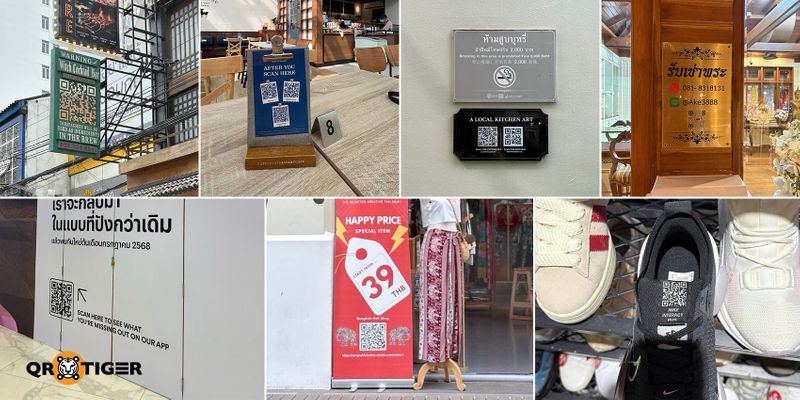
Image Source: Edrian O. | PR & Communications Manager, QR TIGER
Walk the streets of Bangkok, Chiang Mai, or Pattaya, and QR codes will greet you at every corner. They are so common in Thailand that you will be more surprised if you don’t see one in a store.
Recent QR code statistics show they have grown beyond payments to become central to the nation’s digital economy.
They are a natural solution for providing a seamless experience to millions of Thai consumers and international visitors alike. Thailand mainly use them for:
- Instant cashless payments
- Advertising campaigns
- Touch-free dining menus
- Fundraising initiatives
- Guided digital maps
- Accessing government services
- Information drive
From street vendors to big retailers, QR codes are everywhere, and scanning them has become second nature.
💡Did You Know? 75% of Thais use QR codes for cashless payments. A majority of them also have a positive attitude to move toward a cashless society, according to a study by UnionPay International and Nielsen.
The state of the QR code in Thailand: Notable developments
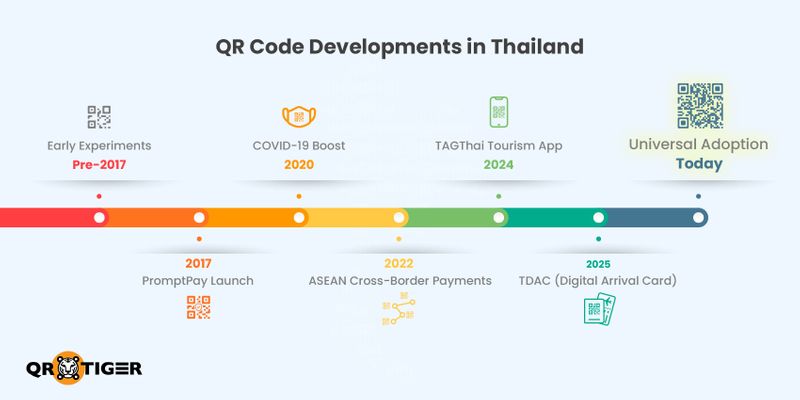
Thailand ranks third worldwide for QR code usage, trailing only China and Malaysia.
The QR code adoption in Thailand didn’t happen by chance. Government initiatives, digital fluent consumers, and cost-effective solutions set the stage for the milestones that shaped QR code use in Thailand.
Here's how ingrained QR codes are to Thais’ daily lives:
Pre-2017 – Early experiments
Before the government standardized the system, QR payments were scattered and used mainly by a few early adopters to exchange payment information.
Adoption was limited, and most businesses and consumers were still unfamiliar with scanning codes for transactions.
2017: PromptPay launch
The government and Bank of Thailand rolled out PromptPay Thailand QR Code, a unified system linking bank accounts and mobile wallets. This provided both consumers and businesses with a trusted, nationwide framework.
The launch boosted confidence in QR payments, making them easier to adopt across retail, services, and everyday transactions.
2020: COVID-19 boost
Contactless safety became essential. QR menus, digital check-ins, and payment systems moved from optional to everyday features almost overnight. The pandemic sped up adoption across restaurants, retail, healthcare, and public services.
The Thai Embassy launched the Thailand Pass QR code, a system that enabled the tracking of travelers and streamlining entry in the country. This initiative shows how QR codes became essential in health and tourism.
2022: Regional cross-border payment integration
ASEAN created the first interoperable QR code payment ecosystem, linking Indonesia, Malaysia, the Philippines, Singapore, and Thailand, making travel and transactions more seamless for ASEAN visitors.
This integration allowed tourists and businesses to complete payments without switching apps or currencies, reinforcing QR codes as a regional digital standard
2024: TAGThai app surge
The government-backed TAGThai tourism app saw explosive adoption, offering travelers QR-based services, promotions, and mobility support.
TAGThai is a centralized tourism app that uses QR codes for digital ticketing, hotel and restaurant check-ins, real-time travel updates, and exclusive deals, simplifying payments and experiences for visitors.
2025 : Thailand Digital Arrival Card (TDAC)
Thailand introduced a QR-powered Digital Arrival Card to streamline immigration and travel processing. The TDAC demonstrated the country’s move toward full digital integration, allowing visitors to complete essential documentation quickly and safely.
The system illustrates how QR codes are used in Thailand to allow visitors to complete essential documentation quickly and securely, reducing wait times and improving the overall travel experience.
Today: Nearly universal adoption
QR codes are now embedded in everyday life, from shopping and healthcare to travel and governance.
The QR code popularity in Thailand shows how a simple payment tool has evolved into a national digital standard, shaping how people live, work, and interact across the country.
Thinking of using QR codes for your business? Creating one has never been easier with the best free QR code generator in the market.
Thai companies with positive adoption of QR codes

Industry reports and recent QR code forecast show steady growth in adoption, confirming that QR codes are here to stay.
These examples highlight how leading Thai brands are transforming simple scans into powerful tools for loyalty, marketing, and customer engagement.
Siam Cement Group
Siam Cement Group (SCG) is leading the adoption of a QR code system to drive digital innovation. Its packaging arm, SCGP, now uses connected packaging by printing unique QR codes on product labels.
Consumers scan to unlock product details, verify authenticity, join recycling rewards, or access promotions. SCG, in turn, gathers analytics on customer behavior and product flow. This helps fight counterfeits while turning packaging into a powerful engagement tool.
SCG uses a dynamic QR code generator to receive updates on campaigns anytime, tracks scan analytics, and adds anti-counterfeit security, transforming packaging into a trust-building, data-driven channel.
Jaspal Group
Top Thai fashion retailer Jaspal Group uses QR codes to engage customers. Shoppers scan in-store codes to join JPS CLUB for perks and offers, while brands like Jelly Bunny use PromptPay QR payments for fast, contactless checkout.
These codes also power in-store promos, giveaways, and styling tips, bridging offline shopping with digital engagement and keeping customers connected beyond the store.
Powered by QR TIGER QR Code Generator, Jaspal runs flexible, cost-efficient campaigns.
A single QR can update anytime to showcase new collections, surveys, or online stores. With analytics and multi-URL routing, every scan drives measurable engagement and loyalty.
7-Eleven Thailand
7-Eleven is also the country’s largest convenience store chain. The company uses QR codes to make shopping faster and more connected. With the rise of digital payments in Thailand, customers enjoy seamless, cashless checkout across thousands of stores.
QR codes enable 7-Eleven’s loyalty and promos, letting shoppers scan to earn points, redeem coupons, or access limited-time deals. They also link to delivery services and the 7-Eleven app, seamlessly bridging in-store convenience with digital engagement.
PTT gas stations
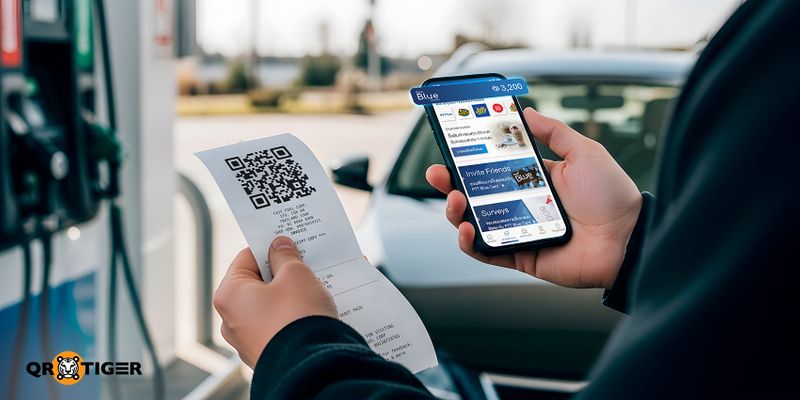
PTT is a leading state-owned oil and gas company that uses the Thailand QR code system to make fueling and services faster and more convenient.
At stations nationwide, drivers scan to join the PTT Blue Card loyalty program, earning points, rewards, and exclusive offers with every visit.
QR codes on receipts, signage, and pumps also link to the PTT app, giving customers instant access to e-coupons, discounts, and station locators, turning everyday refueling into a smart, connected experience.
Gourmet Market
One of Thailand’s leading premium supermarkets, Gourmet Market, uses QR codes to make shopping smoother and more rewarding. At checkout, customers scan to unlock M Card promotions and exclusive KTC JCB credit card discounts.
Through “Call Chat Shop,” customers can order by phone or chat and pay via QR code or card, with delivery or pickup options.
Gourmet Market also enables cross-border digital payments in Thailand, letting tourists scan a QR code via Bangkok Bank to pay from foreign accounts
LINE Thailand
LINE is among Thailand’s most popular messaging and lifestyle apps which plays a key role in the Thai QR code system. Users can instantly add friends or official accounts by scanning a QR code, making connections simple without phone numbers or manual search.
For businesses, LINE uses QR codes in Official Accounts and promos to connect offline campaigns with chats, coupons, and e-commerce. Through LINE Pay, users scan to pay, transfer money, or redeem rewards, making QR codes part of daily life.
Grab Thailand
Grab Thailand integrates QR codes across its ecosystem. Riders and drivers use a travel QR code for quick ride confirmations and safe, contactless interactions.
These travel QR codes also support Thailand’s tourism sector by giving visitors easy access to Grab rides, local promotions, and partner services without language barriers.
By placing codes on posters, vehicles, and partner stores, Grab connects tourists to reliable transport and exclusive deals, making travel in Thailand smoother and more convenient.
Shopee Thailand
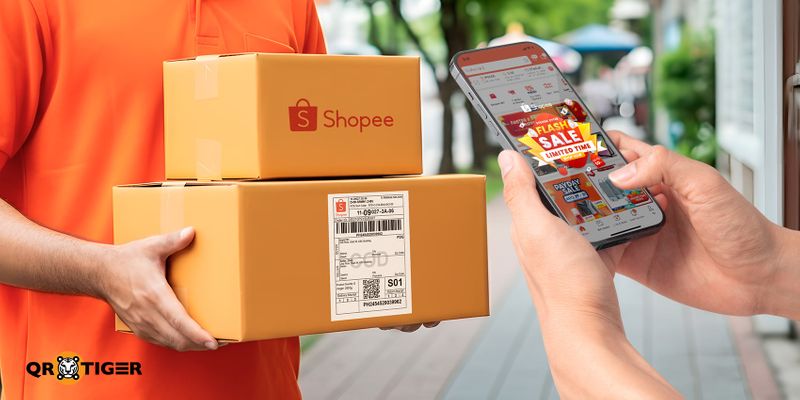
Shopee leverages Thailand QR codes to bridge online and offline shopping. Shoppers scan codes on packaging, flyers, or billboards to unlock deals and flash sales in the app.
The platform also uses QR codes for ShopeePay, its mobile wallet, where shoppers scan to pay in partner stores, transfer funds, or redeem vouchers, making them central to Shopee’s strategy for driving app engagement.
Lazada Thailand
Lazada Thailand taps into QR codes to create more interactive shopping experiences.
Customers scan QR codes on billboards, packaging, or displays to access curated deals, launches, and limited-time campaigns in the Lazada app. With Lazada Wallet, they also scan at partner stores for fast, cashless checkout.
By blending promotions, loyalty rewards, and seamless payments, Lazada makes QR codes a key driver of customer engagement and e-commerce growth in Thailand.
State Railways of Thailand (SRT)
Since autumn 2021, the State Railway of Thailand (SRT) has been rolling out a sleek new generation of train tickets across its national network.
The new SRT tickets include a QR code for transportation along with standard travel details like name, route, date, time, carriage, seat, and fare.
Passengers can now skip paper tickets altogether. Just show the QR code on your phone or tablet for quick scanning, faster boarding, and a more eco-friendly travel experience.
Things to keep in mind when using QR codes in Thailand
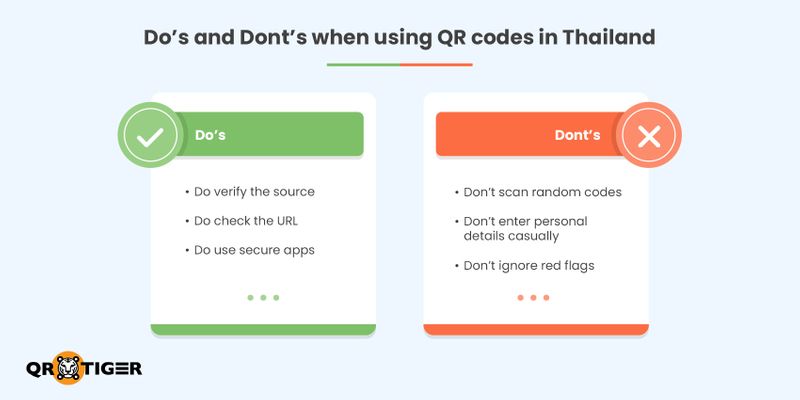
QR codes are now part of everyday life in Thailand, from shopping and dining to travel and payments. But as usage grows, so do the risks. Staying aware helps you enjoy the convenience without falling into traps.
Here are some do’s and don’ts when scanning QR code:
1. Do verify the source. Scan only from trusted businesses, official apps, or verified signage to avoid fake or malicious codes.
2. Do check the URL. Before clicking any link, make sure the web address looks legitimate and matches the brand you trust.
3. Do use secure apps. Stick to well-known apps like PromptPay, Grab, or your bank’s mobile app to process payments safely.
4. Don’t scan random codes. Avoid scanning QR codes from flyers, unsolicited emails, or messages from unknown senders.
5. Don’t enter personal details casually. If a QR code redirects you to a form asking for sensitive information, treat it with caution.
6. Don’t ignore red flags. Misspelled links, pop-ups, or suspicious prompts can be signs of scams. Exit immediately.
Despite these challenges, the future of QR codes in Thailand looks strong. Adoption continues to expand, with steady growth and innovative applications set to make them an even bigger part of the country’s digital landscape.
QR codes as a pillar of Thailand’s digital economy
Thailand is at the forefront of QR code adoption in Asia. This success highlights the power of combining technology, government support, and consumer readiness.
Further developments in cross-border payments and integrated super apps will continue to make QR codes a key driver of Thailand’s digital economy, turning the country into a model for other nations seeking seamless, cashless, and connected experiences.
Harness the power of a dynamic QR code generator to create your own QR codes and join Thailand’s digital revolution. 
FAQs
What is the QR code standard in Thailand?
Thailand’s QR code standard for payments features the Thai QR Payment logo on a dark blue background with white fonts. Any embedded payment icon should stay under 7% of the QR code to ensure readability and compliance.
Which payment apps work in Thailand?
Thailand’s Thai QR code system supports payments through bank apps like K PLUS, SCB Easy, Krungthai NEXT, and e-wallets such as TrueMoney, GrabPay, and Rabbit LINE Pay. Tourists can also pay via cross-border QR, though some apps require Thai ID for full features.
Can GCash QR payment be used in Thailand?
Yes, GCash QR payments can be used in Thailand if the merchant accepts Alipay+ QR payments. Fully verified users can pay cashlessly by scanning these codes, but it’s best to confirm acceptance before relying on GCash.


